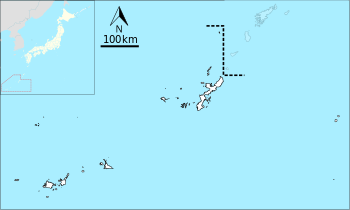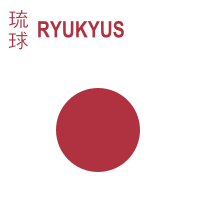الإدارة المدنية الأمريكية لجزر ريوكيو
United States Civil Administration of the Ryukyu Islands 琉球列島米国民政府 Ryūkyū-rettō Beikoku Minseifu | |||||||||||
|---|---|---|---|---|---|---|---|---|---|---|---|
| 1950–1972 | |||||||||||
النشيد: The Star Spangled Banner | |||||||||||
 Territory controlled by USCAR 1955–1972. | |||||||||||
| الوضع | احتلال عسكري | ||||||||||
| العاصمة | ناها | ||||||||||
| أكبر مدينة | العاصمة | ||||||||||
| اللغات المشتركة | اليابانية الإنگليزية ريوكيو | ||||||||||
| الحكومة | احتلال عسكري | ||||||||||
| الرئيس الأمريكي | |||||||||||
• 1950–1953 (first) | هاري ترومان | ||||||||||
• 1969–1972 (last) | ريتشارد نيكسون | ||||||||||
| Governor | |||||||||||
• 1950–1951 (first) | دگلس مكارثر | ||||||||||
• 1955–1957 (last) | Lyman Lemnitzer | ||||||||||
| High Commissioner | |||||||||||
• 1957–1958 (first) | James Edward Moore | ||||||||||
• 1968–1972 (last) | James Benjamin Lampert | ||||||||||
| الحقبة التاريخية | الحرب الباردة | ||||||||||
| 22 June 1945 | |||||||||||
• إدارة مدنية | 15 ديسمبر 1950 | ||||||||||
| 15 مايو 1972 | |||||||||||
| العملة | B yen (July 1948 – Sep 1958) U.S. dollar (1958–1972) | ||||||||||
| |||||||||||
الإدارة المدنية الأمريكية لجزر ريوكيو abbr. USCAR (琉球列島米国民政府, Japanese: Ryūkyū-rettō Beikoku Minseifu, Okinawan: Rūcū ʔAmirika Minhyōjōju) was the civil administration government in the Ryukyu Islands, Japan (centered on Okinawa Island), replacing the United States Military Government of the Ryukyu Islands (itself created at the conclusion of World War II) in 1950, and functioned until the islands were returned to Japan in 1972.[1] It surveiled the native Ryukyuan Government, and could overrule all the decisions made by the native government.
. . . . . . . . . . . . . . . . . . . . . . . . . . . . . . . . . . . . . . . . . . . . . . . . . . . . . . . . . . . . . . . . . . . . . . . . . . . . . . . . . . . . . . . . . . . . . . . . . . . . . . . . . . . . . . . . . . . . . . . . . . . . . . . . . . . . . . . . . . . . . . . . . . . . . . . . . . . . . . . . . . . . . . . .
التاريخ
The U.S. National Archives and Records Administration describes USCAR's history thus:[2]
Following signing of the Instrument of Surrender, 2 September 1945, Ryukyu Islands were administered by Department of the Navy, 21 September 1945 – 30 June 1946, with Commanding Officer, Naval Operating Base, Okinawa functioning as chief military government officer under authority of Commander-in-Chief U.S. Pacific Fleet. Transfer of administration from Department of the Navy to War Department authorized by Joint Chiefs of Staff (JCS) approval, 1 April 1946, of JCS 819/11, 5 March 1946, with added proviso of JCS 819/12, 22 March 1946. Pursuant to implementing instructions of General Headquarters U.S. Army Forces in the Pacific (GHQ AFPAC), Okinawa Base Command redesignated Ryukyus Command, effective 1 July 1946, by General Order 162, Headquarters U.S. Army Forces, Western Pacific, and made responsible for administration under a Deputy Commander for Military Government. Ryukyu Islands administered successively by Ryukyus Command, 1 July – 30 November 1946; Philippines-Ryukyus Command, 1 December 1946 – 31 July 1948; and Ryukyuan Command, 1 August 1948 – 15 December 1950. USCAR established, effective 15 December 1950, by a directive of Headquarters Far East Command (HQ FEC, formerly GHQ AFPAC), AG 091.1 (5 December 1950) RCA, December 5, 1950, implementing a JCS memorandum, SM 2474-50, 11 October 1950, directing Commander-in-Chief Far East, Gen. Douglas MacArthur, to organize a civil administration for the Ryukyu Islands in accordance with JCS 1231/14, 4 October 1950. USCAR continued to function under Department of the Army (formerly War Department), 1950–71. Amami Island Group of Ryukyu Islands was returned to Japan by the Agreement between the United States of America and Japan concerning the Amami Islands, signed 24 December 1953, and made effective 25 December 1953. USCAR abolished following entrance into force, 15 May 1972, of the Agreement between the United States of America and Japan concerning the Ryukyu Islands and the Daito Islands, signed 17 June 1971, by which the remaining island groups of the Ryukyu Islands, including the Okinawa Island Group, were returned to Japan.
After the Battle of Okinawa in World War II, the United States Navy initially administered the Okinawa group while the other three groups came under Army control. On 18 July 1945, the Navy transferred control to U.S. Army Forces in the Pacific (AFPAC), but on 21 September assumed control again, organizing the United States Military Government of the Ryukyu Islands.[3] Finally on 1 July 1946, the Army took control again, organising the Ryukyu Command from the previous Okinawa Base Command. On 1 January 1947, AFPAC was reorganised as Far East Command and a unified Ryukyu Command, including a military government apparatus, was placed under General Headquarters, Far East Command (GHQ FECOM), in Tokyo.
When the Treaty of San Francisco came into force in April 1952, the Ryukyu Islands were placed under U.S. administration temporarily, though their ultimate sovereignty remained with Japan.[4] USCAR, which was a subordinate organization of the forces of the United States, surveilled the native Ryukyuan Government and could overrule all the decisions made by the Ryukyuan Government.[5]
The official currency was the B yen from 1948 to 1958, when the B yen was abolished and the US dollar was brought into use.[6] The government printed Ryukyuan postage stamps and passports. Cars drove on the right in contrast to the main islands of Japan. The island switched to driving on the left in 1978 to bring it in line with Japan.
تفاصيل معاهدة السلام
Two important articles of the post-war peace treaty of 28 April 1952, are the following:[7]
Article 3: Japan will concur in any proposal of the United States to the United Nations to place under its trusteeship system, with the United States as the sole administering authority, Nansei Shoto south of 29 degrees north latitude (including the Ryukyu Islands and the Daitō Shoto), Nanpō Shoto south of Sofu Gan (including the Bonin Islands, Rosario Island and the Volcano Islands) and Parece Vela and Marcus Island. Pending the making of such a proposal and affirmative action thereon, the United States will have the right to exercise all and any powers of administration, legislation and jurisdiction over the territory and inhabitants of these islands, including their territorial waters.
Article 4b: Japan recognizes the validity of dispositions of property of Japan and Japanese nationals made by or pursuant to directives of the United States Military Government in any of the areas referred to in Articles 2 and 3.
After a formal agreement reached on 17 June 1971, control of Okinawa was given back to Japan on 15 May 1972,[8] and USCAR was abolished. This completed the disposition of this Japanese property by USMG.
نظام الحكم
The post of Governor (民政長官, Minsei Chōkan) was created in 1950 and replaced in 1957 by the High Commissioner of the Ryukyu Islands (琉球列島高等弁務官, Ryūkyū-rettō Kōtō-benmukan) until 1972.[بحاجة لمصدر]
الحكام والمفوضون السامون
العلم
The Criminal Code of Ryukyu restricted the flying of any national flags except the flag of the United States.[9] The protesters against the Ryukyu government flew the Hinomaru, the flag of Japan. Civil ships of Ryukyu flew an ensign derived from the International maritime signal flag for "D" instead of Japanese or American ensigns. The ensign changed to "Hinomaru below a triangular flag labeled "Ryukyus" and "琉球" (Japanese for "Ryukyu") in 1967.[10][11]
انظر أيضاً
 Media related to الإدارة المدنية الأمريكية لجزر ريوكيو at Wikimedia Commons
Media related to الإدارة المدنية الأمريكية لجزر ريوكيو at Wikimedia Commons- United States Military Government of the Ryukyu Islands
- Government of the Ryukyu Islands, the body of Okinawan self-governance from 1952 to 1972.
- Koza riot
- ja:琉球列島米国民政府
- شعب ريوكيو
- Ryukyu independence movement
- Postage stamps and postal history of Ryukyu Islands
- Naval Base Okinawa
المراجع
- ^ Sayuri Daimon (May 14, 2002). "Handover of Okinawa to Japan was prickly issue". Japan Times. Retrieved February 13, 2021.
- ^ "Records of U.S. Occupation Headquarters, World War II". National Archives. U.S. National Archives and Records Administration. 1995. Retrieved September 9, 2016.
260.12 Records of the U.S. Civil Administration of the Ryukyu Islands (USCAR) 1945–72
- ^ Eiji Takemae, The Allied Occupation of Japan, p.123
- ^ "The U.S. Returns Okinawa to Japan, 1971". Arlington, Virginia: Association for Diplomatic Studies and Training. July 6, 2016. Retrieved June 6, 2023.
- ^ "Rights of Persons Belonging to Minorities - The Issue of Ryukyu and Okinawa" (PDF). IMADR. Association of the Indigenous Peoples in the Ryukyus, Shimin Gaikou Centre. 2014. p. 7. Retrieved 2023-03-17.
{{cite web}}: CS1 maint: others (link) - ^ Ikeo, Aiko (2014). A History of Economic Science in Japan: The Internationalisation of Economics in the Twentieth Century. Routledge. p. 227. ISBN 9781317747536. Retrieved September 9, 2016.
- ^ قالب:Cite Wikisource
- ^ "Agreement between the United States of America and Japan Concerning the Ryukyu Islands and Daito Islands". United States Treaties and Other International Agreements, Volume 23, Part 1. US Department of State. 23: 449. 1973. Retrieved September 9, 2016.
- ^ "琉球刑法並びに訴訟手続法典(一九五五年) Criminal code of Ryukyu 1955" (in اليابانية). Retrieved December 8, 2007.
- ^ "沖繩船舶旗問題(昭和42年 わが外交の近況) Okinawa Ships issue (Our diplomacy 1967)" (in اليابانية). Retrieved December 8, 2007.
- ^ "那覇 泊港?那覇港? 全琉船舶に新船舶旗掲揚 1967年7月1日 All Ryukyuan ships hold new civil ensign at Tomari port or Naha port in Naha, July 1, 1967" (in اليابانية). Archived from the original on August 1, 2009. Retrieved December 8, 2007.
- CS1 maint: others
- CS1 اليابانية-language sources (ja)
- Pages using gadget WikiMiniAtlas
- Short description is different from Wikidata
- Pages using infobox country or infobox former country with the flag caption or type parameters
- مقالات ذات عبارات بحاجة لمصادر
- Articles with hatnote templates targeting a nonexistent page
- Coordinates on Wikidata
- تأسيسات 1950 في اليابان
- انحلالات 1972 في اليابان
- Former regions and territories of the United States
- Government agencies established in 1950
- Government agencies disestablished in 1972
- History of United States expansionism
- Japan–United States relations
- Okinawa under United States occupation
- Postwar Japan
- Shōwa period




